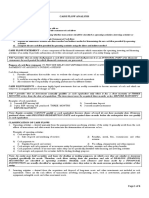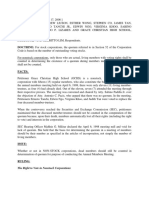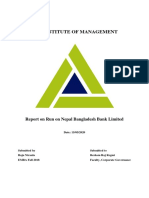0 ratings0% found this document useful (0 votes)
6 viewsCash Flow Statement
project
Uploaded by
l56723905Copyright
© © All Rights Reserved
Available Formats
Download as DOCX, PDF, TXT or read online on Scribd
0 ratings0% found this document useful (0 votes)
6 viewsCash Flow Statement
project
Uploaded by
l56723905Copyright
© © All Rights Reserved
Available Formats
Download as DOCX, PDF, TXT or read online on Scribd
You are on page 1/ 17
Meaning of cash flow statement
A Cash Flow Statement is a vital financial report that outlines the
movement of cash and cash equivalents into and out of an
organization during a specific period. It is an essential tool for
assessing the liquidity position of a company, providing insights into
how cash flows through its operations, investments, and financing
activities. Unlike the Income Statement, which focuses on profits, the
Cash Flow Statement offers a clearer picture of a company's actual
cash position, which is critical for maintaining day-to-day operations,
paying liabilities, and financing future growth.
Examples of operating cash flows include sales of goods and services,
salary payments, rent payments, and income tax payments.
Objective of cash flow statement
The objective of a cash flow statement is to provide stakeholders
with detailed insights into the cash inflows and outflows of a
company during a specific period. This financial report helps in
evaluating how effectively a company manages its cash resources,
and it offers a clear picture of the company’s liquidity, financial
health, and cash-generating capability. The cash flow statement is
organized into three primary activities: operating, investing, and
financing activities, each serving a unique purpose in the assessment
of the company’s financial performance.
1. Operating Activities: This section shows the cash generated or
used by a company’s core business operations. It includes cash
inflows from revenue generated through sales, as well as cash
outflows for expenses such as payments to suppliers, employees, and
operational costs. Additionally, it adjusts for non-cash items, such as
depreciation or changes in working capital (e.g., receivables and
payables). By analysing operating cash flow, stakeholders can assess
whether the company is able to generate enough cash from its day-
to-day business operations to sustain its current activities and
expand. A consistent positive cash flow from operations signals a
financially stable company that can support its growth without
relying on external financing.
2. Investing Activities: The investing activities section reflects cash
flows related to investments in long-term assets and securities. It
includes cash spent on purchasing property, equipment, and
investments, as well as cash received from the sale or disposal of
these assets. This section provides insights into the company's capital
expenditure, acquisition strategy, and overall investment decisions.
Negative cash flow in this section could indicate that the company is
investing heavily in its future growth through acquisitions or asset
purchases, while positive cash flow might suggest the sale of noncore
assets or investments. The pattern of cash flows here helps investors
understand the company’s long-term strategy and capital
management.
3. Financing Activities: This section captures cash flows associated
with the company’s funding decisions. It includes cash inflows from
issuing debt or equity and cash outflows related to repaying debt,
buying back shares, or paying dividends to shareholders. By
examining the financing activities, stakeholders gain an
understanding of how the company raises capital for its operations
and expansion, as well as how it returns value to its shareholders. A
company with significant cash inflows from financing activities may
be raising funds for expansion or acquisitions, while consistent
outflows for debt repayment or dividend distribution could suggest a
stable and shareholder-focused company.
Overall, the cash flow statement is a crucial tool for evaluating a
company’s liquidity, operational efficiency, and financial stability. It
allows investors, creditors, and management to assess the company’s
ability to generate cash, its flexibility in managing financial resources,
and its potential for sustainable future growth. Through this detailed
breakdown, stakeholders can make more informed decisions
regarding investments, credit, and strategic planning.
Procedure of preparing Cash-Flow Statement
"Cash and Cash Equivalents" represent assets that are either
immediately accessible as cash or can quickly convert to cash with
minimal risk, forming an essential part of a company’s liquidity.
Cash typically includes cash on hand and demand deposits in banks.
These demand deposits are funds that can be withdrawn by the
company at any time without prior notice, ensuring immediate
availability for operational or investment needs.
Cash Equivalents are highly liquid, short-term investments that a
company can swiftly convert into known amounts of cash, carrying an
insignificant risk of value fluctuation. For an investment to qualify as
a cash equivalent, two key conditions must be met: (1) it must have a
maturity period of three months or less from the acquisition date,
and (2) it must pose minimal risk in terms of value change.
Examples of cash equivalents include treasury bills, commercial
papers, and short-term government bonds, all chosen to provide
quick access to funds with low risk. Investment in preference shares
can also qualify as a cash equivalent if they are redeemable within
three months and the issuing company has a strong repayment
guarantee. Cash and Cash Equivalents, therefore, comprise assets like
(i) cash on hand, (ii) bank deposits, (iii) short-term marketable
securities, and (iv) cheques and drafts on hand, all crucial for a
company’s short-term financial flexibility.
Cash Flows from Operating Activities represent the cash
transactions related to the primary revenue-generating activities of
an enterprise. These activities include the core functions involved in
producing goods or delivering services, reflecting the daily business
operations that contribute to profit or loss. Operating cash flows
generally consist of:
1. Cash Receipts from Sales and Services: Cash generated from the
direct sale of goods and services provided by the company, forming
the main income source.
2. Cash Receipts from Royalties, Fees, Commissions, and Other
Revenue: These include income streams from licensing, consultancy,
and service-based fees.
3. Cash Receipts from Debtors and Bills Receivables: Money received
from customers who previously purchased on credit, helping
maintain the company’s liquidity.
4. Cash Payments for the Purchase of Goods and Services: Outflows
related to procuring raw materials, inventory, and services necessary
for business operations.
5. Cash Payments to Creditors and Bills Payable: Payments made to
suppliers and creditors to settle outstanding debts.
6. Cash Payments for Wages, Salaries, and Employee Benefits:
Employee compensation, including regular wages and other related
costs.
7. Cash Payments or Refunds of Income Taxes: Taxes related to
operating activities, unless specifically connected to financing or
investing activities.
Cash Flows from Investing Activities represent the cash transactions
associated with the acquisition and disposal of long-term assets and
investments not classified as cash equivalents. These activities
typically involve the purchase and sale of resources aimed at
generating future revenue and profits, rather than immediate
returns.
Examples of cash flows from investing activities include:
1. Cash Payments to Acquire Property, Plant, Equipment, and
Intangible Assets: Outflows related to purchasing fixed assets like
buildings, machinery, and intangible assets, such as patents,
necessary for future production and operations.
2. Cash Receipts from Sale of Property, Plant, Equipment, and
Intangible Assets: Cash inflows from selling long-term assets, often
part of asset restructuring or replacement.
3. Cash Payments to Acquire Shares, Warrants, or Debt Instruments
of Other Companies: Investments in other companies’ securities
(excluding those considered cash equivalents) to diversify or
strategically position the business.
4. Cash Receipts from Sale of Shares, Warrants, or Debt Instruments:
Cash inflows from divesting investments in other companies, often
driven by profit realization or liquidity needs.
5. Cash Advances and Loans Made to Third Parties: Outflows related
to providing financial assistance to other entities, either short- or
long-term.
6. Cash Receipts from Repayment of Advances and Loans: Inflows
from the repayment of funds lent to others, aiding in liquidity.
7. Cash Receipts from Insurance Claims for Property Loss: Inflows
from insurance settlements for damages to assets.
Cash Flows from Financing Activities reflect the cash movements
resulting from changes in a company’s capital structure, including
equity financing and borrowings. These activities demonstrate how a
company funds its operations and growth, providing insights into its
financing strategy and capital management.
Examples of cash flows from financing activities include:
1. Cash Receipts from Issuing Shares or Similar Instruments: Inflows
from selling equity shares or other instruments, often used to raise
capital for expansion.
2. Cash Receipts from Borrowings: Inflows from taking on short-term
or long-term debt, including issuing debentures, bonds, or obtaining
loans.
3. Cash Payments for Buy-Back of Equity Shares: Outflows to
repurchase shares, often to reduce equity or return capital to
shareholders.
4. Cash Repayments of Borrowings: Outflows related to repaying
debts, including redeeming debentures, bonds, preference shares,
and loans.
5. Cash Payments for Dividends: Outflows for interim and previous
year's dividends on preference and equity shares, returning value to
shareholders.
6. Cash Payments for Interest on Borrowings: Payments of interest on
both long-term (debentures) and short-term borrowings (bank
overdrafts and cash credit).
7. Changes in Bank Overdraft and Cash Credit: Adjustments to bank
overdrafts and cash credit balances, reflecting changes in short-term
borrowing arrangements.
FORMAT OF CASH FLOW STATEMENT
Sum
Sum
Sum
You might also like
- Understanding Financial Statements of Mining CompaniesNo ratings yetUnderstanding Financial Statements of Mining Companies104 pages
- Quiz - Merchandising BSA 101 2015-2016 With Solution100% (1)Quiz - Merchandising BSA 101 2015-2016 With Solution7 pages
- Unit 4: Statement of Cash Flow & Statement of Retained EarningsNo ratings yetUnit 4: Statement of Cash Flow & Statement of Retained Earnings10 pages
- Summary Report - Group 2: Definition of TermsNo ratings yetSummary Report - Group 2: Definition of Terms8 pages
- Unit Ii Cash Flow Analysis: Noncash Revenues and ExpensesNo ratings yetUnit Ii Cash Flow Analysis: Noncash Revenues and Expenses6 pages
- Textbook of Urgent Care Management: Chapter 46, Urgent Care Center FinancingFrom EverandTextbook of Urgent Care Management: Chapter 46, Urgent Care Center FinancingNo ratings yet
- Review of Journal Entries, T-Accounts, General Ledger, and Trial Balance100% (1)Review of Journal Entries, T-Accounts, General Ledger, and Trial Balance25 pages
- Hedging Techniques For Interest Rate Risk: MenuNo ratings yetHedging Techniques For Interest Rate Risk: Menu12 pages
- Lecture Investment in Debt Securities PDFNo ratings yetLecture Investment in Debt Securities PDF4 pages
- Full Test Bank For Accounting Principles 13th Edition Weygandt All Chapters100% (11)Full Test Bank For Accounting Principles 13th Edition Weygandt All Chapters54 pages
- P U P College of Accountancy and Finance: First Evaluation Exams Practical Accounting 2No ratings yetP U P College of Accountancy and Finance: First Evaluation Exams Practical Accounting 210 pages
- Indian Accounting Standards (Abbreviated As Ind-AS) in India Accounting Standards100% (1)Indian Accounting Standards (Abbreviated As Ind-AS) in India Accounting Standards6 pages
- Tan v. Sycip - G.R. No. 153468 (Case Digest)100% (1)Tan v. Sycip - G.R. No. 153468 (Case Digest)2 pages
- To Be Printed Part 1a and Part 1b Computations No Answer100% (1)To Be Printed Part 1a and Part 1b Computations No Answer112 pages
- Department of Finance and Accounting: IBS, IFHE, HyderabadNo ratings yetDepartment of Finance and Accounting: IBS, IFHE, Hyderabad54 pages
- Job-Order Costing: Cost Flows and External ReportingNo ratings yetJob-Order Costing: Cost Flows and External Reporting58 pages
- Applying The Restatement Approach Under IAS 29 Financial Reporting in Hyperinflationary EconomiesNo ratings yetApplying The Restatement Approach Under IAS 29 Financial Reporting in Hyperinflationary Economies6 pages
- BANKNIFTY Options Open Interest AnalysisNo ratings yetBANKNIFTY Options Open Interest Analysis20 pages
- Illustrative Problem - Financial Ratios: (Including Depreciation P5,000 For 2020 and P 3,000 For 2019)No ratings yetIllustrative Problem - Financial Ratios: (Including Depreciation P5,000 For 2020 and P 3,000 For 2019)5 pages
- Understanding Financial Statements of Mining CompaniesUnderstanding Financial Statements of Mining Companies
- Quiz - Merchandising BSA 101 2015-2016 With SolutionQuiz - Merchandising BSA 101 2015-2016 With Solution
- Unit 4: Statement of Cash Flow & Statement of Retained EarningsUnit 4: Statement of Cash Flow & Statement of Retained Earnings
- Unit Ii Cash Flow Analysis: Noncash Revenues and ExpensesUnit Ii Cash Flow Analysis: Noncash Revenues and Expenses
- Textbook of Urgent Care Management: Chapter 46, Urgent Care Center FinancingFrom EverandTextbook of Urgent Care Management: Chapter 46, Urgent Care Center Financing
- Review of Journal Entries, T-Accounts, General Ledger, and Trial BalanceReview of Journal Entries, T-Accounts, General Ledger, and Trial Balance
- Full Test Bank For Accounting Principles 13th Edition Weygandt All ChaptersFull Test Bank For Accounting Principles 13th Edition Weygandt All Chapters
- P U P College of Accountancy and Finance: First Evaluation Exams Practical Accounting 2P U P College of Accountancy and Finance: First Evaluation Exams Practical Accounting 2
- Indian Accounting Standards (Abbreviated As Ind-AS) in India Accounting StandardsIndian Accounting Standards (Abbreviated As Ind-AS) in India Accounting Standards
- To Be Printed Part 1a and Part 1b Computations No AnswerTo Be Printed Part 1a and Part 1b Computations No Answer
- Department of Finance and Accounting: IBS, IFHE, HyderabadDepartment of Finance and Accounting: IBS, IFHE, Hyderabad
- Job-Order Costing: Cost Flows and External ReportingJob-Order Costing: Cost Flows and External Reporting
- Applying The Restatement Approach Under IAS 29 Financial Reporting in Hyperinflationary EconomiesApplying The Restatement Approach Under IAS 29 Financial Reporting in Hyperinflationary Economies
- Illustrative Problem - Financial Ratios: (Including Depreciation P5,000 For 2020 and P 3,000 For 2019)Illustrative Problem - Financial Ratios: (Including Depreciation P5,000 For 2020 and P 3,000 For 2019)

























































































